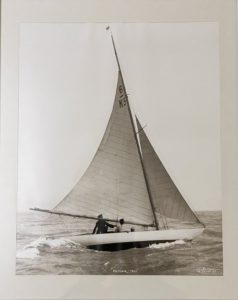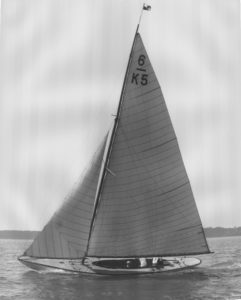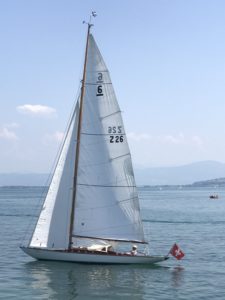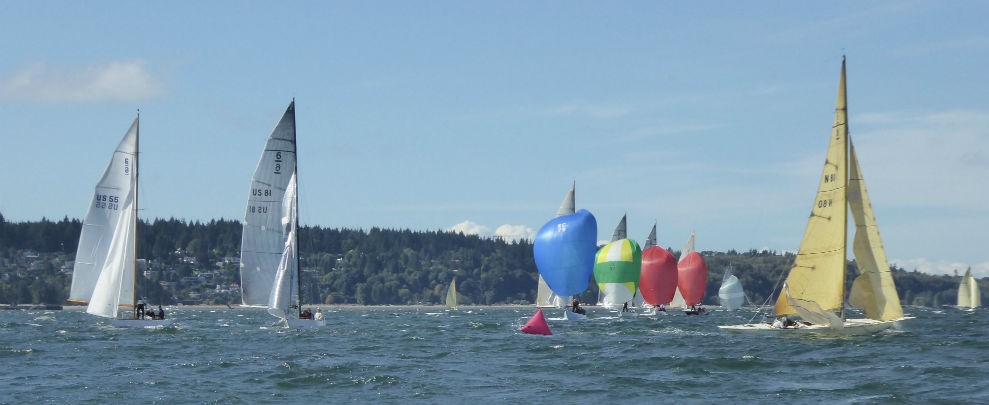The boats that sailed a century ago – part 7: Victoria
July 19th, 2021
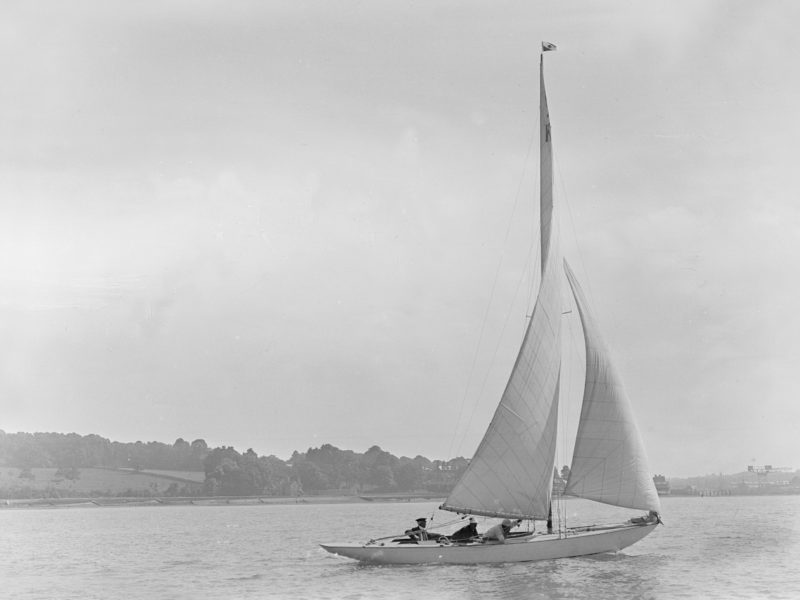
100 years of racing
2021 is the centenary year of the British American Cup, the first major trophy for international team racing. The competition was hugely popular and was a further boost for the increasingly successful International Six Metre Class.
The eight entrants in 1921 – four each for Britain and America – were launched in the same year. This article is part of a series of posts to mark the centenary of the launch of the eight pioneering international team racing boats.
The British team – Victoria
Victoria was designed by Alfred Mylne and built in 1921 at his Bute Slip Dock Co. yard on the Isle of Bute on the west coast of Scotland, surrounded by mountains, and a rich heritage of whisky distilling and boat building. Victoria was a good looking boat.
Alfred Mylne, like his mainland neighbour and fellow British American Cup designer William Fife III, had designed Six Metres since the beginning – a total of 13 before 1921. Only G U Laws (19) and Frank Morgan Giles (20) had more designs built in the same period.
Sibindi was Mylne’s first Six, built in 1908 by F G Maynard. The first built at the Bute Slip Dock was Schelm in 1911. Victoria was the first Second rule Six Metre Class yacht built at Bute. She was built for Sir William P Burton K.B.E of Burstall, Ipswich and Sir Godfrey P Collins, K.B.E., C.M.G., M.P.
William Burton was a famous and prolific amateur skipper. He was at the helm of Sir Thomas Lipton’s Shamrock IV (Charles Nicholson design) at the America’s Cup in 1913, and was also known for sailing 52 footers, as well as International 12, 15 and 19 Metres. As such, he was the most experienced racer on the British team for the British American Cup.
Godfrey Collins was a publisher and a Scottish Liberal Party politician. He joined the Royal Navy in 1888 and was a midshipman, East Indian Station from 1890 to 1893. He was elected as Liberal Member of Parliament for Greenock in 1910 and sat for the constituency until his death.
He was Parliamentary Private Secretary to J B Seely, as Secretary of State for War from 1910 to 1914, and to J W Gulland, Chief Liberal Whip from 1915. He served in Egypt, Gallipoli, and Mesopotamia from 1915 to 1917, and was appointed a Lieutenant Colonel in September 1916. He was a Junior Lord of the Treasury from 1919 to 1920.
The races
Victoria came fifth in the first British American Cup race and was disqualified in the second for reportedly “fouling the mark in rounding the east buoy.” She followed this up by coming seventh, sixth and fourth in the following three races. After five of the six races Victoria was well behind the rest of the British in total points and behind two of the Americans. Victoria and fellow team mate Jean both saved the best till last, coming first and second respectively with only 29 seconds between them, but a clear gap of nearly 20 minutes from the third placed Grebe.
Burton and Collins were joined by a Miss Rhodes among the crew. Sherman Hoyt, captain of the American Sheila recalled in his memoirs:
“The crews of Six Metres were in their first years limited to “four unless one or more were ladies when five might be carried.” I had noticed that on heavy weather days, my friend, Willie (later Sir William) Burton of Shamrock IV association, shipped as a fifth member on his little light weather Six, the Victoria, a Miss Rhodes. This young girl, undoubtedly of good family, was of tender age but of enormous weight. I conceived the idea of having a bit of fun with the authorities and requested an opportunity, as captain of the American team, to ask for an interpretation of certain rules. I was told the Committee would meet me at the Squadron at ten that night. Well fortified with a dinner and good cheer at the Royal London, I duly appeared and solemnly asked for a definition of a lady. Citing the case of young Miss Rhodes and her undoubted good breeding, what would happen if I, having little acquaintance with the local gentry, went up to town, picked up a stout female, but hardly a lady in the normal understanding of that term, brought her to Cowes and used her for ballast on my craft? Would I be subject to protest? The Committee at first appeared stumped, but one or two who knew me well suddenly realized I was only fooling and I was politely and laughingly told to go to hell. Nevertheless the rule was changed in the following winter and crews of Six Metres have ever since been limited in number to five, irrespective of sex.”
After the British American Cup

Victoria was later renamed Gerris and her sail number became K26. Image from archive record MKBS.1.5. © Beken of Cowes
Sir William Burton raced his second Six Metre, the Camper and Nicholsons Capelle, in the 1923 British American Cup, again at Ryde and Cowes. Britain won and Capelle performed well but the points tally fell behind that of team mates. She didn’t finish the fifth race making her the only boat during that year’s competition to fail to complete all six races. The reason they failed to finished may not have been as surprising as it would today, though no less unnerving. Burton and crew were disqualified after steering Capelle into an area where there were live mines.
In 1925 Victoria was registered in Greenock, home to Sir Godfrey Collins, but owned by Ernest Davis who lived in Auckland, New Zealand. How and why Davis came to own a yacht in the UK is a mystery. He was a wealthy brewer, married to a famous opera singer, and was mayor of Auckland. Davis was photographed alongside Sir Thomas Lipton and Sir William Burton in 1920 on Lipton’s steam boat Erin, so a connection is apparent.
It has not yet been possible to identify all crew members for the British team: Davis may even have been on Victoria in the 1921 competition.
By 1929 Victoria was bought by Robert Tronchin and Jaques Colle of Geneva and taken to Switzerland, where she would remain in ownership to this day.
Today

Victoria at her current home in Arbon, Switzerland
Victoria and Sheila are the only two of the eight original British American Cup boats that are currently sailing, and both are in excellent condition. The rest have been destroyed or as in the case of Polly, are unfit to sail and are awaiting restoration.
Victoria was refurbished by Georg Smits in Arbon, and is now owned by Markus Borsani and sails on Lake Constance in Switzerland (also known as Bodensee) along with a number of other Sixes.
Mr. Borsani described his experience with Victoria.
“I do not actively participate in regattas. I use Victoria as a fast touring yacht and spend my weekends and holidays with her. Of course, I am still in love with the beautiful design.”
“Lake Constance tends to be a light wind area. With the current sail plan, I reach hull speed with about 10 knots of wind. The 2nd rule 6mR tend to be light wind yachts, Victoria confirms this, for me a typical second rule boat. From 12-13 knots of wind, I reduce the foresail area, of course also to protect the old wooden mast. I once sailed briefly on a modern 6mR. They can take much more wind.”
“Victoria has a very pleasant behaviour in waves, as the line is straight from the bow down to the keel.”
An article written by Markus Borsani is due to be published in 2021 in the German Yacht magazine.
Posted in Anniversary by James Harris on July 19th, 2021. Tags: British American Cup, Sailing, Six Meter, Six Metre, Victoria, William Fife
Subscribe to comments | Both comments and pings are currently closed.
We need your support
Support our project and submit your records or make a donation to the International Six Metre Archive.
